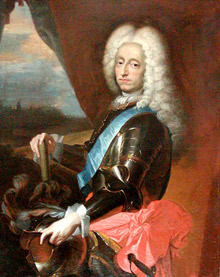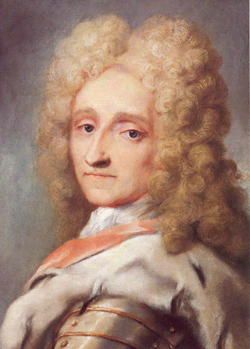|
 Frederick IV,
(*11 October 1671 – †12 October 1730)
was the king of Denmark and Norway from
1699 until his death. Frederick was the
son of
Christian V
and
Charlotte Amalie of Hesse-Kassel.
For much of Frederik IV's reign Denmark was
engaged in the Great Northern War
(1700-1721) against Sweden. A first
short-lived encounter 1700 ended
with a Swedish invasion
and threats from Europe's western
naval powers. In 1709 Denmark again
entered the war encouraged by the
Swedish defeat at Poltava.
Frederick IV commanded the Danish
troops at the battle of Gadebusch in
1712. Although Denmark emerged
on the victorious side,
she failed to reconquer lost
possessions in southern Sweden.
The most important result was the
destruction of the
pro-Swedish duchy of
Holstein-Gottorp re-establishing
Denmark's domination in Schleswig-Holstein.
Frederick IV,
(*11 October 1671 – †12 October 1730)
was the king of Denmark and Norway from
1699 until his death. Frederick was the
son of
Christian V
and
Charlotte Amalie of Hesse-Kassel.
For much of Frederik IV's reign Denmark was
engaged in the Great Northern War
(1700-1721) against Sweden. A first
short-lived encounter 1700 ended
with a Swedish invasion
and threats from Europe's western
naval powers. In 1709 Denmark again
entered the war encouraged by the
Swedish defeat at Poltava.
Frederick IV commanded the Danish
troops at the battle of Gadebusch in
1712. Although Denmark emerged
on the victorious side,
she failed to reconquer lost
possessions in southern Sweden.
The most important result was the
destruction of the
pro-Swedish duchy of
Holstein-Gottorp re-establishing
Denmark's domination in Schleswig-Holstein.
His most important domestic
reform was the abolition in 1702 of the
so-called vornedskab, a kind of serfdom
which had fallen on the
peasants of Zealand in the later Middle
Ages. His efforts were largely in vain
because of the introduction of adscription in 1733.
After the war, trade and culture flowered.
The First Danish theatre, Lille
Grönnegade was created and
the great dramatist Ludvig
Holberg began his career. Also the
colonisation of Greenland was
started by the missionary Hans
Egede. Politically this period was
marked by the king's connection
to the Retentions, the Holsteiner
relatives of his last queen, and by his growing
suspicion toward the old nobility.
 During Frederick's rule Copenhagen was
struck by two disasters: the plague of 1711,
and the great fire of October 1728 which
destroyed most of the medieval capital.
Although the king had been persuaded
by Ole Rømer to introduce the
Gregorian calendar in Denmark-Norway
in 1700, the astonomer's observations
and calculations were among the
treasures lost to the fire.
Frederik IV, having twice visited Italy,
had two pleasure palaces built in the
Italian baroque style:
Frederiksberg Palace
and
Fredensborg Palace,
both considered monuments to the
conclusion of the Great Northern War.
During Frederick's rule Copenhagen was
struck by two disasters: the plague of 1711,
and the great fire of October 1728 which
destroyed most of the medieval capital.
Although the king had been persuaded
by Ole Rømer to introduce the
Gregorian calendar in Denmark-Norway
in 1700, the astonomer's observations
and calculations were among the
treasures lost to the fire.
Frederik IV, having twice visited Italy,
had two pleasure palaces built in the
Italian baroque style:
Frederiksberg Palace
and
Fredensborg Palace,
both considered monuments to the
conclusion of the Great Northern War.
Frederick was deemed a man
of responsibility and industry — often regarded
as the most intelligent of Denmark's
absolute monarchs. He seems to have mastered
the art of remaining independent
of his ministers. Lacking all interest
in academic knowledge,
he was nevertheless a patron of
culture, especially in art and architecture.
His main weaknesses were probably
pleasure-seeking and womanising
(he is the only Danish king known
to have committed bigamy),
which sometimes distracted him.
During King Frederick's last
years he was afflicted with weak health and
private sorrows that
inclined him toward Pietism. That form of faith
would rise to prevalence during the reign of his son.
On his death in 1730, Frederick IV was interred in
Roskilde Cathedral.
|
 History
History
 Dates and events
Dates and events
 Persons
Persons
 Poltava
Poltava
 Sights
Sights
 Photo gallery
Photo gallery
 Maps
Maps
 Virtual Museum
Virtual Museum
 Armament
Armament
 Uniforms
Uniforms
 Coins and medals
Coins and medals
 Flags
Flags
 Paintings
Paintings
 Poltava photographs
Poltava photographs
 News
News
 About us
About us
 Acknowledgments
Acknowledgments
 Main page
Main page
 top
top ...back
...back  History
History
 Dates and events
Dates and events
 Persons
Persons
 Poltava
Poltava
 Sights
Sights
 Photo gallery
Photo gallery
 Maps
Maps
 Virtual Museum
Virtual Museum
 Armament
Armament
 Uniforms
Uniforms
 Coins and medals
Coins and medals
 Flags
Flags
 Paintings
Paintings
 Poltava photographs
Poltava photographs
 News
News
 About us
About us
 Acknowledgments
Acknowledgments
 Main page
Main page